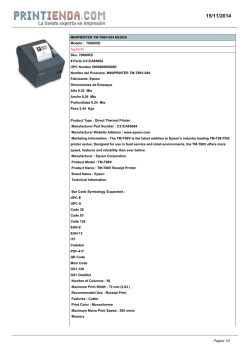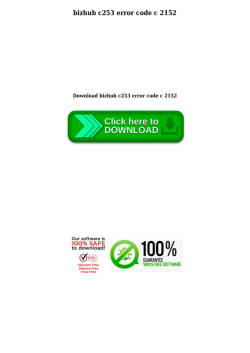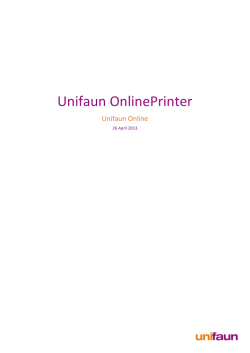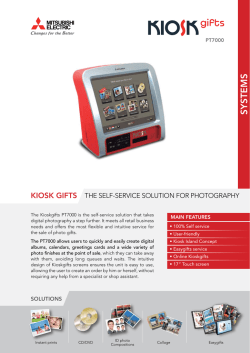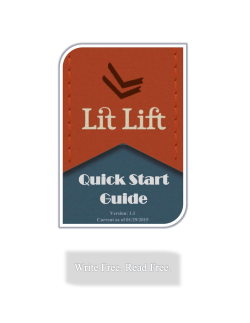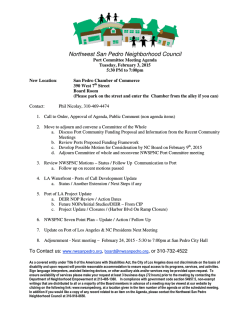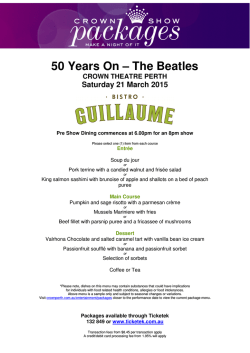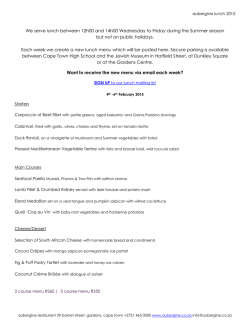
ITT4100 POSline®
ITT4100 POSline®
Thermal Transfer Printer
User's Manual
2. Power Supply
3. Parts and Features
WARNING:
NEVER OPERATE THE PRINTER AND POWER SUPPLY IN
AN AREA WHERE THEY CAN GET WET.
1. The Power Adapter has a barrel connector on one end that
must be inserted into the power jack on the back of the printer.
2. Plug the other end of the cord into an appropriate AC electrical
outlet.
3. When plugging the connector into power jack, please leave the
power switch at "O" position and don't touch the 36 pin parallel
connector.
Ready Indicator
Top Cover
Power Indicator
AC Electrical Outlet
Power Jack
Feed Button
Power Switch
Power Switch
Power Adapter
Barrel Connector
3
4
4. Loading the Ribbon
Note:
This section is not applicable to the direct thermal printing.
Media Hanger
Release Levers
1. Lift the top cover to expose the media compartment.
Ribbon Pick-up Holder
Ribbon Supply Holder
Thermal Printhead
5
6
2. Unlatch the print head module by pushing the two white release
levers on the sides toward the rear.
3. Turn over the print head module to expose the ribbon supply
holder.
Media Compartment
4. Unwrap the ribbon roll pack and separate the ribbon roll and
the bare core.
5. Attach the edge of the ribbon on the bare core and wind it a
little bit onto the core.
6. Insert the ribbon roll into the supply holder. (First snap in the left
side and then the right side.)
Release Lever
Ribbon Roll
Print Head Module
Ribbon Supply Holder
Bare Core
7
8
7. Turn back the print head module and then insert the bare core
into the pick-up holder. (First snap in the left side, then the right
side.)
8. Turn the wheel of the print head module to ensure the ribbon is
tightly wound.
9. Press down the print head module on both sides firmly till you
hear a snap.
Wheel
Print Head Module
9
10
5. Loading the Media
A Series printers can be operated in three different options:
standard, peel-off, or with a cutter.
2. Remove the media hanger.
3. Load the media roll onto the hanger.
4. Unlatch the print head module.
5. Left the peeler cover easy for label easy into the slot.
- Standard mode allows you to collect each label freely.
- In peel-off mode, the backing material is being peeled away from
the label as it is printed. After the former label is removed, the
next one will be printed.
- In cutter mode, the printer automatically cuts the label after it is
printed.
Standard Mode
1. Lift the top cover to expose the media compartment.
Media Hanger
Media Compartment
Ribbon Roll
Peeler Cover
11
12
6. Lead the label through the media guides with the other hand.
The media guide can be adjusted centrality to well fit with
different label width.
7. Press down the print head module firmly on both sides till you
hear a snap.
Print Head Module
Media Guides
13
14
8. Close the top cover and turn on the printer or press the feed
button if the printer is already on.
Peel Off Mode
1. Loose two attached screws on the back of peeler cover.
2. Remove the peeler cover.
Screw
Feed Button
15
16
3. Plug in the dispenser connecter.
4. Mount the dispenser module.
5. Secure two attached screws on the back of peeler cover.
6. Lead the label through the media guides and dispenser.
Dispenser Connecter
Screw
Media Guides
Dispenser Module
Dispenser
17
18
7. Press down the print head module firmly till you hear a snap.
8. Close the top cover and turn on the printer or press the feed
button if the printer is already on.
9. Press the feed button and the label backing paper will come out
from the slot under dispenser.
Feed Button
Label
Feed Button
Backing Paper
Note :
The feed button will not drive the printer to peel. The
peeling function can be executed only when the software
setting is ready.
19
20
4. Loose the screw on the printer module.
5. Remove the dispenser bar.
Cutter Mode
1. First plug cutter baby board in JP29 on the main board.
2. Loose two attached screws on the back of peeler cover.
3. Remove the peeler cover.
Screw
Screw
Peeler Cover
Dispenser Bar
21
22
6. Plug in the cutter connecter.
7. Secure the screw of cutter module.
8. Lead the label through the media guides and the slot of cutter.
9. Press down the print head module firmly on both sides till you
hear a snap.
Cutter Connecter
Media Guides
Print Head Module
Screw
Cutter Module
23
24
10. Close the top cover and turn on the printer or press the feed
button if the printer is already on.
6. Operator Controls
Power Switch
Feed Button
Controls printer power
On-normal operation
Off-the power should be turned off before connect or disconnect
the communication cables and power cables
Feed Button
Advance the label media to first printing position
Press to advance a label
Press to take the printer out of a "pause" condition
Keep pressing while turning on the power to print out a
configuration profile
Ready Indicator
Note:
The feed button will not drive the printer to cut. The
Show the printers status
Green : printer is ready to operate
Blinking : printer is paused
cutting function can be executed only when the software
Power indicator
setting is ready.
Shows the power and error status
Off-printer power off
Green : printer power on
Blinking : error occurs
25
26
7. Performing Calibration
Ready Indicator
Top Cover
1. Keep pressing the feed button while turning on the power, until
the printing motor becomes activated.
2. The calibration has been performed while the printer
automatically feed label stock for certain length.
Note:
This step is very important and must always be carried
out whenever media is being changed. Failure to do so
will result in miss-detection of the label sensor.
Power Indicator
Feed Button
Power Switch
27
28
8. Printing Configuration Report
1. Keep pressing the feed button while turning on the power, until
the printing motor becomes activated.
2. After feeding 12-inch blank media, the printing motor will
suspend for one second, then it will print out the configuration
profile. This profile states the firmware version, ROM checksum,
RS232, thermal transfer/direct thermal settings, hardware
configuration and font types.
3. At PPLB emulation, the printer will enter character dump mode.
To exit from dump mode, just re-start the printer again.
29
9. Resetting the Printer to Factory
Default Settings
1. Turn on the printer and wait for 5 or more seconds.
2. Press the feed button for about 10 seconds, then the ready
indicator and the power indicator will go off in order.
3. While two indicators become lit again, release the feed button.
4. At this moment, the printer will feed the label stock 12 inches in
length, and come back to the factory default settings.
Note :
All settings are stored in non-volatile E2PROM and
cannot be destroyed even turn off the printer.
30
10. Hooking up the Printer and Computer
Power Jack
Note :
The power supply barrel connector must be inserted into the
power jack on the back of the printer before connecting the
communication cables.
This printer comes with both a nine-pin Electronics Industries
Association (EIA) RS-232 serial data interface, a standard
Centronics parallel interface and USB interface. In either case,
you must supply the required interface cable for your application.
Note :
This printer complies with FCC "Rules and Regulations" ,
Part 15, for Class A Equipment, using fully shielded six-foot
data cables. Use of longer cables or unshielded cables may
increase radiated emissions above the Class A limits.
RS232 Serial Port
USB port
Parallel Port
Serial (RS-232) Interface Requirements
The required cable must have a nine-pin "D" type male connector
on one end, which is plugged into the mating serial port located
on the back of the printer. The other end of this signal interface
cable connects to a serial port at the host computer.
For technical and pin-out information, please refer to the
Reference Technical Information-Interface Specification on page
55 of this booklet.
31
32
Parallel Interface Requirements
11. Communicating with the Printer
The required cable (IEEE 1284-compliant is recommended) must
have a standard 36-pin parallel connector on one end, which is
plugged into the parallel port located on the back of the printer.
The other end of the parallel interface cable connects to the
printer connector at the host computer. For pin-out information,
refer to the Reference Technical Information- Interface
Specification. Serial and Parallel Cabling Requirements.
The bundled printer driver can be applied to all the applications
under Windows 98/ME/2000/XP, and Windows NT. Through this
driver you may run any popular software applications e.g.
MS-Word and print out the contents by this label printer as long as
they are for Windows.
Data cables must be of fully shielded construction and fitted with
metal or metalized connector shells. Shielded cables and
connectors are required to prevent radiation and reception of
electrical noise.
Before installation
1. Check the contents of the driver to ensure it is complete.
2. Make a backup copy of this driver.
3. Read the read.txt file for installation guide and change notices.
To minimize electrical noise pickup in the cable:
■Keep data cables as short as possible (6 [1.83m]
recommended).
■Do not tightly bundle the data cables with power cords.
■Do not tie the data cables to power wire conduits.
Notes :
1. Using Centronics allows for a much higher speed
communication than the use of a serial.
2. It is not necessary to set the switch or send any command
to select the parallel or serial port . The printer can
automatically detect it.
3. The default settings can be read from the configuration
report.
33
34
Installing USB Driver (Windows 98 only)
❑ Install USB driver
Properties menu
→ Click “Next “.
→ Select "Specify
a location".
→ Right click to get
pop-up menu.
→ Click “Next “.
→ Select "Specify
a location".
Notes: Uninstall printer driver before installing USB driver.
→ Select "Driver".
→ Click “Update Driver”.
35
36
Installing Printer Driver
1. Click the "Start" button.
2. Select "Settings", then select "Printers" and double click the
"Add Printer" icon. Click "Next".
3. Click the "Network" or "Local" button and click the "Next"
button.
4. Click "Have Disk", click the pull-down menu to select CD ROM
driver path.
5. Click "Browse" button.
6. Select the proper directory for installation:
-WIN98
-WIN ME
-WIN2000
-NT4.0 (No support USB)
- WIN XP
Notes :
1. If you are just updating your driver, make sure to delete
the previous version first.
2. Uninstall printer driver before installing USB driver.
3. If you install a new bar code application software like
ArgoBar, LabelView or CodeSoft, the Label Dr. 200 (or
Label Dr. 300) driver should be activated and set as the
current printer driver:
ArgoBar
File
→
New
→
Select Printer
→
Label Dr. on LPT1:
→
OK
LabelView
File
→
Select Printer
→
Label Dr. on LPT1:
→
OK
CodeSoft
7. The driver name "Label Dr. 200" (or Label Dr.300) will appear
in the "List of Printers", click "Next".
8. Select the communication port for the label printer. For parallel
port, select "LPT1 :", "LPT2 :" or "LPT3 :" , for serial port, select
"COM1 :" or "COM2 :", for USB port, select “USB001”,
“USB002” .
9. After the related files have been copied to your system, the
installation is complete.
10. If you need to print from the label printer, set "Label Dr. 200"(or
Label Dr.300) as the Default Printer.
37
File
→
Printer
→
Windows
→
Label Dr. on LPT1:
LabelMatrix
File
→
Printer Setup
→
Label Dr. on LPT1:
38
→
OK
→
OK
Set the Parameters
For Win 98 / ME
After installing the driver, you can follow the path below to set
parameters:
❑ Ports
Properties menu
Start
→
Settings
→
Printers
→
Label Dr.
→
Properties
The parameters include:
→ Click "Details".
→ Select the IO port.
→ Click "OK".
Ports Select the IO port to link with the printer. The port may be one of
parallel (LPT), serial (COM), network port or file.
Paper size Select the proper size on the menu. If there is no desired
size, select "Custom" to define the paper size.
Orientation Set portrait or landscape according to the print direction.
Paper source (Media type) T/T stands for thermal transfer (ribbon)
mode and D/T for direct thermal mode (without ribbon).
Media choice (Darkness) Set the heat value or darkness from this
field. The darkness value ranges from 0 to 15.
Copies This function designates the number of printed copies of each
page.
More option (Accessory setting) To use the cutter and peeler
function you still need to enter More Options and select one of the items.
Device options (Speed) Set the print speed. For the ITT4100,
the speed ranges from 1 to 4 IPS.
39
❑ Paper size
❑ Orientation
❑ Paper source
(Media type)
❑ Media choice
(Darkness)
❑ Copies
Properties menu
→ Click "Paper".
→ Click each item to select
desired parameter.
→ Click "OK".
40
❑ Output bin
❑ Create a new size
Properties menu
(Accessory setting)
Properties menu
→ Click "Paper".
→ Select "Custom".
→ User-Define size.
→ Set up a new size.
→ Click "OK".
→ Click "Paper".
→ Click "more option".
→ Select Enable/without
cutter, peeler.
→ Click "OK".
❑ Print quality (Speed)
Properties menu
→ Click "Device Options".
→ Select parameters.
→ Click "OK".
41
42
For Win 2000
❑ Orientation
Printing Reference menu
❑ Ports
Properties menu
→ Click "Layout".
→ Select "Portrait" or
"Landscape".
→ Click "OK".
→ Click "Ports".
→ Select the IO port.
→ Click "OK".
❑ Paper size
❑ Copies
❑ Media choice
❑ Paper source
(Accessory setting)
(Media type)
❑ Paper/Output
Back to Printers menu
→ Right click to get
pop-up menu.
→ Select "Printing
Reference".
→ Click "Paper Quality"
select media type.
→ Click "OK".
(Speed)
❑ Print quality
(Darkness)
Printing Reference menu
→ Click "Layout".
→ Click "Advanced" button.
→ Click each item to select
the parameters.
→ Click "OK".
43
44
For NT 4.0
❑ Create a new size
Printer menu
❑ Ports
→ Right click to get popup menu on empty space.
→ Select "Server
Properties".
→ Enter a form name for
the new form in "Form
description for".
→ Reset the paper size in
the specific squares
of the "Measurements".
Properties menu
→ Click "Ports".
→ Select the IO port.
→ Click " OK".
→ Click "OK".
❑ Paper size
❑ Orientation
❑ Paper source
(Media type)
❑ Copies
❑ Media choice
(Accessory setting)
Printer’s menu
→ Right click to get
pop-up menu.
→ Select "Document
Defaults".
→ Click "Advanced" button.
→ Click each item to
select desired parameter.
45
46
❑ Paper/Output (Speed)
For Win XP
❑ Print quality (Darkness)
❑ Ports
Properties menu
Default Document menu
→ Click "Advanced".
→ Click each item to
select desired
parameter.
→ Click "OK".
→ Click "Ports".
→ Select the IO port.
→ Click "OK".
❑ Create a new size
Please refer to the
procedure of create a
new size on Win 2000.
❑ Paper source (Media type)
Back to Printers menu
→ Label Dr.
→ Right click to get
pop-up menu.
→ Select "Printing
Reference".
→ Click "Paper Quality".
→ Select media type.
→ Click "OK".
47
48
❑ Orientation
Printing Reference menu
❑ Create a new size
Printer menu
→ Click "Layout".
→ Select "Portrait" or
"Landscape".
→ Click "OK".
→ Right click to get
pop-up menu in
blank space.
→ Select "Server
Properties".
→ Enter a form name
for the new form in
"Form name”.
→ Reset the paper size
in the specific
squares of the "Form
description"
→ Click "OK".
❑ Paper size
❑ Copies
❑ Media choice
(Accessory setting)
❑ Paper/Output (Speed)
❑ Print quality (Darkness)
Printing Reference menu
→ Click "Layout".
→ Click "Advanced" button.
→ Click each item to select
the parameters.
→ Click "OK".
49
50
B. Power and Ready LEDs blink alternately
12. Troubleshooting
Normally, when the printer is in abnormal condition, the power
LED will keep blinking. The printing work and the communication
between the host and printer will stop.
To understand the problem, please check both
LEDs first:
A. Power and Ready LEDs blink at the same tempo
Power LED Ready LED
ON
ON
OFF
OFF
Possible
Problems
Miss-detect the gap
Power LED
ON
OFF
Ready LED
OFF
ON
Possible Problems
Ribbon out
Ribbon jam
Ribbon sensor error
Solutions
Remarks
Not applicable to
Supply the ribbon roll
direct thermal type.
Recover the jam
Replace the ribbon sensor
C. Only the Power LED blinks
Solutions
. Check the label path
. Check the label sensor
Label stock out
. Supply the label roll out
Label stock not
installed
Label jam
. Install the label roll
Remarks
If you are using
continuous label roll
and run under
Windows, you should
select the continuous
media.
Power LED
ON
OFF
Ready LED
ON
ON
Possible
Problems
Serial IO error
Memory full
Cutter failed, or
jam at cutter
Solutions
Remarks
. Check the baud rate
Add the extension RAM
. Check the cutter
. Recover the jam
Not for Centronics
Hardware error
Call for service
. Recover the jam
51
52
It occurred, only when
cutter is installed, or the
setting of the cutter
Poor printout quality.
D. Miscellaneous
The host shows "Printer Time out"
1. Check if the communication cable(parallel, serial or USB) is
connected securely to your parallel or serial port on the PC and to
the connector on the printer at the other end.
2. Check if the printer power is turned on.
If the power cord is connected, the power switch is at position "I" and
the power LED has still not illuminated, check the fuse inside the
power adapter case.
The data has been sent, but there is no output from the printer. Check
the active printer driver, if Label Dr. for your Windows system and the
label printer has been selected.
. The ribbon may not be qualified.
. The media may not be qualified.
. Adjust the Darkness(heat temperature).
. Slow down the print speed.
. Refer to the next chapter and clean the related spare parts.
Recovery
To continue your print jobs after the abnormal conditions have been
corrected, simply press the panel button or restart the printer. Make sure
that the LED is not blinking and remember to resend your files.
Vertical streaks in the printout usually indicate a dirty or faulty print
head.(Refer to the following example)
Clean the print head first, if they still persist, replace the print head.
53
54
13. Caring for Your Printer
Clean the following areas of the printer after 8 rolls of label stocks
have been used. In each case, use a cotton bud dampened with
alcohol. Do not soak the cotton bud excessively.
Replacing Thermal Print Head
1. Switch off the power and wait for both LEDs to go off.
2. Push print head module and pull it down as the 2 arrows shown
to release print head module from printer chassis.
Note :
Always switch off the power before cleaning.
Cleaning
Thermal Print Head
Thermal paper stock and ribbon will release debris on the print
head and degrade printing quality. Clean the print head with
methanol or isopropyl alcohol with a cotton bud. Do not touch
the heater element with your fingers. Debris or dirt on the roller
should be cleaned with alcohol.
Push
Paper Sensor
Debris or dirt on the paper sensor will cause a miss-read or
unstable detection of the label gap. Clean with a cotton bud
dampened with alcohol.
55
56
3. Loose the 4 screws (C) to take out print head from print head
module (12, 13).
4. Unplug the 2 print head cables from the connectors on print
head to take off the old print head.
5. Plug the 2 print head cable to the new print head.
6. Screw the new print head on print head module (12,13).
7. Put back new print head module on printer chassis with the
same way, which you released it from printer chassis.
14. Reference Technical Information
General Specifications
Specifications
Printing method
Printing
resolution
Printing speed
Printing length
(C)
ITT4100C*
203 dpi
(8dots/mm)
2 ~ 4 ips
(51 ~ 75mm/s)
(51~ 102 mm/s)
1” ~ 8”
1” ~ 45”
300 dpi
(12dots/mm)
2~3 ips
(51 ~ 75 mm/s)
1” ~ 8”
(25mm ~ 203mm)
(25mm ~ 143mm)
(25mm ~203mm)
Max 4.1”
(104 mm)
512KB DRAM
2 MB Flash
ROM
16 bit CISC
microprocessor
Max 4.1”
(104 mm)
2 MB DRAM
2 MB Flash
ROM
32 bit RISC
microprocessor
Reflective
See - through
LED
indicators x 2
Button x 1
Media sensor
Reflective
Display
LED
indicators x 2
Operation
interface
Button x 1
Button x 1
Communication
interface
Centronics
RS-232 serial
Memory
CPU type
Fonts
57
ITT4100B
Max 4.1”
(104 mm)
2 MB DRAM
2 MB Flash
ROM
32 bit RISC
microprocessor
Reflective
See - through
LED
indicators x 2
Printing width
(12)
(13)
ITT4100A*
Thermal Transfer
203 dpi
(8dots/mm)
2~3 ips
Centronics
Centronics
RS-232 serial
RS-232 serial
Bi-USB
Bi-USB
(Full Speed)
(Full Speed)
Int’l character sets standard
5 alpha-numeric fonts from .049”~ .23”H
(1.25mm~6.0mm)
All fonts are expandable up to 24x 24
4 direction 0º~270º rotation
Soft fonts are downloadable
58
Barcodes
2D Barcodes
Graphic
Software
Media
Ribbon
Mechanism
request
Power source
Agency listing
Operation
environment
Optional items
Code 39, Extended Code 39, Code 93, Code 128 UCC
Code 128(Subset A, B, C) Codabar, Interleave 2 of 5,
EAN-8 2&5 add on, EAN-13, EAN-128, UPC, UPC-A,
E 2&5 add on, POSTNET, German POST, Matrix 25
Maxicode, PDF-417,
PCX bit map, GDI graphics
PPLB Language
Windows Driver (98/2000/NT/XP)
Label editing software – ArgoBar
Print Utility
Roll-feed, die-cut, continuous, fan-fold, tags, ticket in
thermal paper or plain paper and fabric label
Max width 4.25” (108 mm)
Min width 1.0” (25.4 mm)
Thickness .0025”~. 01” (.0635mm ~. 254mm)
Max roll capacity 5” (127 mm) OD
Core size 1” (25mm) ID
Wax, Wax/Resin, Resin (Outside coating ribbon)
Ribbon width – 2”, 4”
Ribbon roll – max OD 1.5” (38 mm)
Ribbon length – max 1182’ (100 M)
Core size - ID 0.5” core (13 mm) with notch
Build-in Tear off bar, front-open cover, clear window,
fan fold paper back cover, same mechanism structure,
face-out ribbon run way, face-in media run way,
un-adjustable TPH carrier
110/220 VAC ± 10%, 50/60 Hz, external power adapter
CE, UL, CUL, FCC class A, CCC
40ºF ~ 100ºF (4ºC~38ºC) ; 10~90% non condensing
Cutter, Dispenser kit, Real time clock card, ArgoNet
print server, ArgoKee, 2MB Asian Font card
(Traditional Chinese, Simplified Chinese, Korean and
Japanese)
*MODELOS NO DISPONIBLES.
59
Fonts, Bar Codes and Graphics Specification
The specifications of fonts, bar codes and graphics depend on the
printer emulation. The emulation PPLB is a printer programming
language, through which the host can communicate with your
printer.
Printer Programming Language B, PPLB
Specification
ITT4100A*
ITT4100B
ITT4100C*
General fonts 5 fonts with different point sizes
Symbol sets 8 bits: code page 437, 850, 852, 860,
(Code pages) 863,865,857,861,862,855,866,737,851,869 and
Windows 1250,1251,1252,1253.1254,1255.
7 bits: USA, British, German, French, Danish, Italian,
Spanish, Swedish and Swiss.
Soft fonts
Downloadable soft fonts
Font
1x1 to 24x24
expandability
Bar code
Code 39(checksum), Code 93, Code 128/ subset
types
A,B,C, Codabar, Interleave 2 of 5(checksum), Matrix
25, UPC A/E 2 and 5 add-on, EAN-8/13, Code
128UCC, UCC/EAN, Postnet, German Postcode.
MaxiCode and PDF417 (2D symbologies)
Graphics
PCX and binary raster
*MODELOS NO DISPONIBLES.
Notes :
1. The bare core for ribbon must be 11 cm in length. It should
have two opposite slits at two ends. If the ribbon itself is
less than 11 cm, it has to be aligned with the bare core at
left end when you install it.
60
2. Since this printer uses band buffer technology, if you just
print texts or barcodes the maximum length can be more
than 30 inches, whereas if you print many graphics the
maximum length can only be few inches under standard
onboard RAM.(The extension RAM, font board and flash
modules use the same connector, they cannot function at
the same time.)
Interface Specifications
USB Interface Requirement
2
1
3
4
USB series “B” Receptacle Interface
Pin
1
2
3
4
Signal Name
VBUS
DD+
GND
Connector Terminal Pin Assignment
Serial
The RS232 connector on the printer side is a female, DB-9.
Pin
Direction
Definition
1
In
DSR
2
In
RxData
3
Out
TxData
5
Ground
6
Out
DTR
7
Out
RTS
8
In
CTS
9
Out
+5V
Note :
Pin 9 are reserved for KDU(keyboard device unit), therefore
do not connect these pins if you are using a general host like
a PC.
61
62
Connection with host:
Pin 3- TxData ………
Pin 5- Ground ………
Host 25S
Printer 9P
(PC or compatible)
Host 9S
Printer 9P
(PC or compatible)
DTR 20
DSR 6
TX 2
RX 3
CTS 5
RTS 4
GND 7
DTR 4
DSR 6
TX 3
RX 2
CTS 8
RTS 7
GND 5
……
……
……
……
……
……
……
1 DSR
6 DTR
2 RX
3 TX
7 RTS
8 CTR
5 GND
……
……
……
……
……
……
……
1 DSR
6 DTR
2 RX
3 TX
7 RTS
8 CTS
5 GND
Alternatively you can just connect the 3 wires in the following way.
Host 25S
Printer 9P
(PC or compatible)
Host 9S
Printer 9P
(PC or compatible)
TX 2
RX 3
GND 7
pin 4
pin 5
pin 6
pin 20
TX 3
RX 2
GND 5
pin 4
pin 6
pin 7
pin 8
…… 2 RX
…… 3 TX
…… 5 GND
…… 2 RX
…… 3 TX
…… 5 GND
RxData
Ground
In general, as long as the data quantity is not too large and you
use Xon/Xoff as flow control, it will be problem free.
Baud rate : 2400, 4800, 9600, 19200 and 38400.
(programmable by command)
Data format : always 8 data bits, 1 start bit and 1 stop bit.
Parity : always non parity
Handshaking : XON/XOFF as well as CTS/RTS (hardware flow
control).
If you run an application with the bundled printer driver under
Windows and use the serial port, you should check the above
parameters and set the flow control to "Xon/Xoff "or "hardware".
The most simple way to connect to other hosts (not PC
compatible) or terminals is:
Printer
Pin 2- RxData ………
Terminal/Host
TxData
63
64
Parallel (Centronics)
ASCIITABLE
The parallel port is a standard 36-pin Centronics. Its pin
assignments are listed as following.
Pin
1
2
3
4
5
6
7
8
9
10
11
12
Direction
In
In
In
In
In
In
In
In
In
Out
Out
Out
Definition
/STROBE
Data1
Data 2
Data3
Data4
Data5
Data6
Data7
Data8
/ACK
BUSY
PE
Pin
13
14,15
16
17
18NC
19~30
31
32
33~36
Direction
Out
Out
-
Definition
SELECT
NC
Ground
Ground
Ground
NC
/Fault
NC
0
1
5
6
7
0
@
P
'
P
1
2
SON XON
STX
!
"
1
2
A
B
Q
R
a
b
q
r
3
4
5
XOFF
#
3
C
S
c
s
$
4
D
T
d
t
%
5
E
U
e
u
NAK
6
ACK
&
6
F
V
f
v
7
BEL
‛
7
G
W
g
w
8
BS
(
8
H
X
h
x
)
9
I
Y
i
y
*
J
Z
j
z
+;
:
;
K
[
k
{
LF
ESC
B
65
4
NUL
A
Both the serial port and parallel port of this printer can be
activated at the same time, i.e the printer can simultaneously
communicate with two PC via different port. However as no port
contention is made for this printer, if both PC transmit data at the
same time to this printer, the data may become damaged in the
receiving buffer.
3
0
9
Auto Polling
2
C
FF
,
<
L
\
1
I
D
CR
-
=
M
]
m
}
E
SO
RS
.
>
N
^
n
~
F
SI
US
/
?
O
_
o
DEL
66
© Copyright 2025
